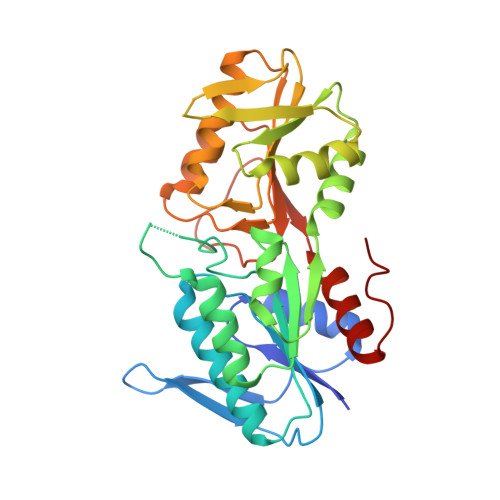Binding of cations in Bacillus subtilis phosphoribosyldiphosphate synthetase and their role in catalysis.
Eriksen, T.A., Kadziola, A., Larsen, S.(2002) Protein Sci 11: 271-279
- PubMed: 11790837
- DOI: https://doi.org/10.1110/ps.28502
- Primary Citation of Related Structures:
1IBS - PubMed Abstract:
The binding sites for the two cations essential for the catalytic function of 5-phospho-D-ribosyl alpha-1-diphosphate (PRPP) synthases have been identified from the structure of the Bacillus subtilis phosphoribosyldiphosphate synthetase (PRPPsase) with bound Cd(2+). The structure determined from X-ray diffraction data to 2.8-A resolution reveals the same hexameric arrangement of the subunits that was observed in the complexes of the enzyme with the activator sulfate and the allosteric inhibitor ADP. Two cation binding sites were localized in each of the two domains of the subunits that compose the hexamer; each domain of the subunit has an associated cation. In addition to the bound Cd(2+), the Cd(2+)-PRPPsase structure contains a sulfate ion in the regulatory site, a sulfate ion at the ribose-5-phosphate binding site, and an AMP moiety at the ATP binding site. Comparison of the Cd(2+)-PRPPsase to the structures of the PRPPsase complexed with sulfate and mADP reveals the structural rearrangement induced by the binding of the free cation, which is essential for the initiation of the reaction. The comparison to the cPRPP complex of glutamine phosphoribosylpyrophosphate amidotransferase from Escherichia coli, a type I phosphoribosyltransferase, provided information about the binding of PRPP. This strongly indicates that the binding of both substrates must lead to a stabilized conformation of the loop region, which remains unresolved in the known PRPPsase complex structures.
- Centre for Crystallographic Studies, Department of Chemistry, University of Copenhagen, 2100 Copenhagen, Denmark.
Organizational Affiliation:



















